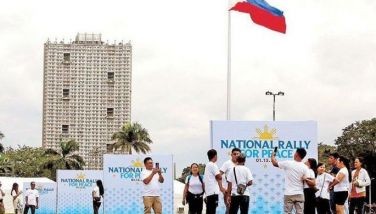‘The China Dream’

With China’s estimated 1.4 billion population to date, the Communist Party leadership is ready and willing to admit that at least 120 million live below the poverty line. This means less than ten percent of the Chinese people are poor.
If we are to believe their official pronouncements, the number of poor people all over China has been effectively reduced to 84 million this year since Beijing first launched its grand poverty reduction program. And by the year 2020 – or six years from now – the Chinese leadership vowed poverty incidence in China will be wiped out.
For a centrally planned economy like China whose leaders are driven by long-term visions for their country, this is no empty boast.
As the world’s largest and fastest growing economy, China is endowed with many resources to lick the poverty problem afflicting what could be a seemingly small part of their population. The central government in Beijing is making sure this national goal is achieved to raise the per capita income of each Chinese at par, if not more than international standard.
This is what they call “the China dream” of prosperity and peace for all people. The “China dream,” put forth by incumbent Chinese President Xi Jinping, is to build a moderately prosperous society and realize national rejuvenation.
It is obviously a takeoff from “the American dream” popular catch phrase in the United States to describe a person’s aspiration to get rich, and have a happy and successful life if one works hard for it. But “the China Dream” is the dream of a nation as echoed by their leader.
This was impressed upon us in the city of Nanning in Guangxi province where the 15-man Philippine media delegation was taken in one of the four-leg Southwest China Cultural and Economic Familiarization Tour.
Organized by the Chinese Embassy in Manila, headed by their newly installed ambassador to the Philippines, Zhao Jianhau, the Philippine media delegation were taken to these on-site ocular visits and official briefings in each leg of the tour. Obviously following a very distinct program designed for the four-leg tour of Southwest China, we covered key subject matters at each stop, namely, disaster mitigation (Sichuan earthquake rehabilitation); poverty reduction (Guangxi); the South China Sea issues (Haikou, Hainan), and special tourism zones (Sanya, Hainan).
If we are to interpret the selection of these subject matters, it was designed to show us this is how Chinese leadership does similar policy programs being done in the Philippines under the administration of President Benigno “Noy” Aquino III.
This is the first Southwest China program taking place at a time bilateral relations between China and the Philippines reached a sore point since 2012 after President Aquino rightfully pressed our claims over the West Philippine Sea islands, atolls, reefs and rocks that are within what China calls its “nine-dash lines” in South China Sea.
In our official briefings here, it was impressed upon us that China remains open to any joint development of the disputed areas in South China Sea. But the state-owned China National Offshore Oil Corp. reportedly has not responded to a standing offer by a Filipino-British company Forum Energy PLC to explore Reed Bank, northwest of the Philippine island of Palawan.
While he was on official trip in the US last week, President Aquino echoed concern that two Chinese hydrographic ships sighted in June by the Philippine military at the disputed Reed Bank indicated China has been doing its own exploration attempt to drill for oil.
This even as Beijing frowned on Manila’s decision to bring before an international arbitration tribunal the overlapping maritime claims in the mineral-rich South China Sea waters.
Outside this issue, our Chinese host took us next to a resettlement site where local officials showed how the Central government and the local councils are working jointly to address poverty in Guangxi Zhuang Autonomous Region. Guangxi, one of five autonomous regions in China, has total population of 51.52 million.
About 10 million of ethnic minorities are classified poor. They are being resettled in the mainstream of their economy literally by taking them from their ethnic abodes in the mountains to live in flat areas where they are allocated agricultural lands to cultivate and subsidized housing. So far, local officials tell us the poverty incidence in Guangxi has been drastically reduced to 6.34 million people this year.
Unlike the outright “dole-out” of Conditional Cash Transfer (CCT) program being implemented by the Philippine government, the central government in Beijing infuses job-generating infrastructure development; access to affordable electricity and water; direct assistance to farm and livestock production; and state subsidies for every family who will send their child to school.
Guangxi is located in the South of China, which is situated in the so-called ASEAN (Association of South East Asian Nations) Economic Rim. In fact, Guangxi’s capital city of Nanning has been declared the permanent venue of the China-ASEAN Expo, or CAExpo.
In the just concluded 11th CAExpo held last week in Nanning City, President Xi’s latest brainchild called “Maritime Silk Road” was formally unveiled. It is an apparent bid by China to push maritime cooperation and trade with the ten-member states of ASEAN that includes the Philippines, Vietnam, Malaysia, Indonesia and Brunei that have overlapping claims over the disputed chain of islands in the South China Sea.
In the post-CAExpo briefing given to us, we were told total trade of China with the ASEAN member-states reached a “historical high” of $443.6 billion last year compared to the measly $100 billion when CAExpo trading first started in 2004.
With the ASEAN Free Trade Area poised to start next year, China has already prepositioned itself to reap the seamless trading scheme while other countries are just watching and waiting on the sidelines.
Thus, “the China dream” is not far from the horizon where the Chinese people can see it. In his last two years in office, we are still to hear from President Aquino what is his dream for the country in the long term, at least what he wants to achieve by the end of his term in June, 2016.
- Latest
- Trending




























